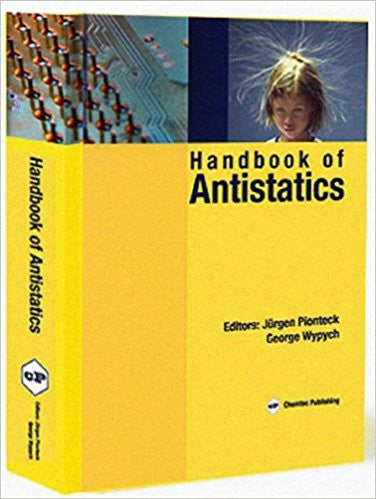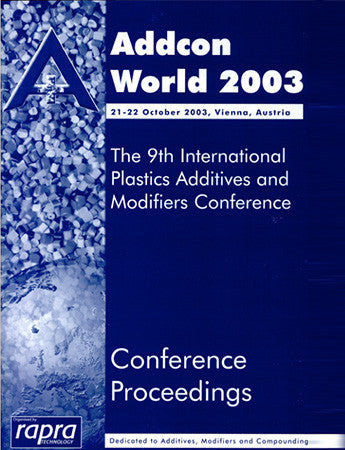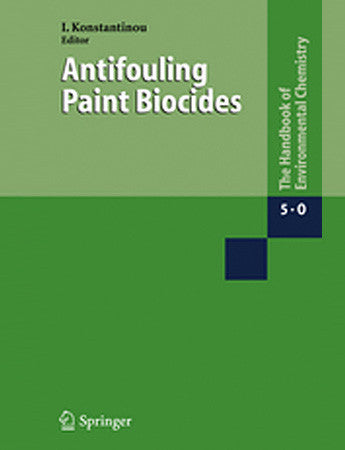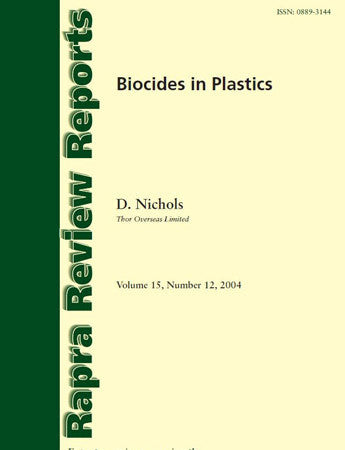The present volume includes information based on the complete review of existing literature and patented inventions on additives capable to modify properties of materials in such a manner that they become antistatic, conductive, and/or EMI shielding.
Thirteen chemical families of materials are used for a production of antistatic additives. There are about 700 commercial products derived from these developments and used by industry to change electric conductivity of materials. The properties of these commercial products are given in the extensive database of antistatics which constitutes a separate publication but useful together with this handbook (see separate publication: Database of Antistatics). The information in both publications is not repeated but it is complementary.
Antistatic additives are used in the production of materials from 57 generic families of polymers and numerous polymer blends having excellent conductive properties. Polymers containing antistatic additives are processed by 18 groups of processing methods and, in addition, 9 incorporation methods are used on the commercial scale with these products. The processing methods are used by 40 industries, listed in the box on the left side of the page, for the manufacture of a large number of commercial products.
Information on use of additives in various polymers is divided into the following sections: types and concentrations of antistatics used, the potential effect of antistatics on polymer and/or other additives, and examples of typical formulations used for processing of polymers containing the antistatic additive.
Information on use of additives in various products is divided into the following sections: types and concentrations of antistatics used by a particular industry, reasons for their use, advantages, and disadvantages of the use of different additives, the effect on product properties, and examples of formulations.
Processing methods are discussed using the following breakdown: types and concentrations of antistatics, eventual influence on processing, and examples of formulations. The goal of this chapter is to provide information on the amount and the type of antistatics used in each processing method, discuss the eventual influence of antistatics on a process and give examples of typical formulations used by the discussed here processing methods.
The book contains 22 chapters, each addressing specific aspect of properties and applications of antistatic agents. Please review the attached table contents for a detailed list of topics, ideas, and reviews included in this comprehensive volume. In addition, a separate publication is also available (Database of Antistatics), which is a database of commercial materials used as antistatic additives in various (not only polymeric) materials.
The combination of the data and the comprehensive analysis of the performance of these materials form very important source of information for industry, research, academia, and legislature. These publications should be considered by any industrial, university, governmental, and public library because of widespread applications of these additives in the industry and everyday life.
1.1 Historical developments in studies on static electricity
1.2 The triboelectric series and electrostatic charging
1.3 Electrical properties of plastics
1.3.1 Electrical conductivity
1.3.2 Dielectric behavior of plastics in low electric fields
1.3.3 Electrostatic charging of dielectric polymers
1.3.4 Stability of plastics in high electric fields
1.4 Antistatic agents
1.4.1 Classification of antistatics
1.4.2 Expectations from antistatics
1.5 Definitions
References
2 Types of Antistatic Agents
2.1 Introduction
2.2 Characteristic properties of industrial antistatic agents
2.2.1 Amines (quaternary and others)
2.2.2 Carbon black
2.2.3 Esters
2.2.4 Fibers
2.2.4.1 Metal
2.2.4.2 Carbon and graphite fibers
2.2.4.3 Others
2.2.5 Inorganic materials
2.2.6 Masterbatches
2.2.7 Metal powders and nanopowders
2.2.8 Nanotubes
2.2.9 Polyethylene glycol
2.2.10 Polymers
2.2.10.1 Inherently conductive
2.2.10.2 Containing antistatic
3 Typical Methods of Quality Control of Antistatics
3.1 Abbreviations, terminology, and vocabulary
3.2 Acid number
3.3 Brookfield viscosity
3.4 Capacitance
3.5 Chemical resistance
3.6 Color
3.7 Compression set
3.8 Dielectric breakdown voltage
3.9 Dielectric constant (relative permittivity)
3.10 Dielectric strength
3.11 Dissipation factor
3.12 Dry arc resistance
3.13 Electrical resistivity
3.14 Erosion resistance
3.15 Flash and fire point
3.16 Hardness
3.17 Kinematic viscosity
3.18 Loss index
3.19 Marking (classification)
3.20 Melt rheology
3.21 Refractive index
3.22 Residual contamination
3.23 Saponification value
3.24 Specific gravity
3.25 Specifications for commercial products and standard test methods
3.25.1 Adhesive bonding
3.25.2 Aviation and distillate fuels
3.25.3 Conductive adhesives
3.25.4 Conveyor belting
3.25.5 Crosslinkable ethylene plastics
3.25.6 Electrical insulating materials
3.25.7 Electrocoat bath
3.25.8 Electronic devices
3.25.9 Endless belts
3.25.10 Extruded film and tape
3.25.11 Flooring
3.25.12 Footwear (protective)
3.25.13 Hoses
3.25.14 Insulation shielding materials
3.25.15 Liquid paints
3.25.16 Medical applications
3.25.17 Polymer-based microwave circuit substrates
3.25.18 Protective clothing
3.25.19 Rubber
3.25.20 Textile fabric
3.25.21 Ventilation materials
3.25.22 Writing paper
3.26 Tensile properties
3.27 Thermal expansion coefficient
3.28 Water concentration
3.29 Weight loss
References
4 Electrostatic Hazards
4.1 Electrostatic charge generation
4.2 Electromagnetic interference
References
5 Ignition Hazards and Preventive Measures
5.1 Conditions of ignition
5.2 Types of discharge and discharge energy
5.3 Minimum ignition energy
5.4 Preventive measures
References
6 Mechanisms of Action of Antistatic Agents
Petra Pötschke & Jürgen Pionteck
6.1 Conductive modification of polymer surfaces
6.2 Mechanism of action of antistatics added into bulk
6.2.1 Internal organic antistatics
6.2.2 Conductive inorganic fillers
6.2.3 Conductive inorganic materials in blends of insulating polymers
6.2.4 Conductive polymer/insulating polymer composites
6.3 Consideration of mechanism in selection of antistatic agents for particular application
References
7 Compatibility of Antistatic Agents with Matrix and Their Performance
7.1 What influences compatibility of antistatic agents with matrix?
7.2 Methods of antistatic agent selection based on principles of compatibility
7.3 Influence of compatibility on permanence of antistatic agent incorporation
References
8 Antistatic Agent Motion and Diffusion
8.1 Antistatic agent diffusion rate and the methods of study
8.2 Antistatic agent motion and distribution in matrix
References
9 Structure and Distribution of Non-migrating Antistatics
9.1 Morphological structure and distribution of non-migrating (permanent) antistatics
9.2 Percolation threshold
References
10 Antistatic Agent Incorporation Method and Its Performance
10.1 Grafting
10.2 Chemical modification
10.3 Surface coating
10.4 UV and electron beam curing
10.5 Plasma treatment
10.6 Physical vapor deposition
10.7 Mixing/dispersion
10.8 Crystallization in matrix
10.9 Nucleation of inorganic nanoparticles
References
11 Antistatic Agents and Other Components of Formulation
11.1 Antistatic agent consumption by fillers
11.2 Absorption of additives by antistatic agents
11.3 Molecular mobility and transport in the presence of antistatic agents
11.4 Effect of antistatic agents on polymerization and curing reactions
11.5 Effect of moisture and humidity
References
12 Effect of Antistatic Agents on Some Properties of Compounded Materials
12.1 Mechanical properties
Mária Omastová
12.2 Optical properties
Mária Omastová
12.3 Spectral properties
12.4 Rheological properties
Petra Pötschke
12.4.1 Effect of low molecular weight organic additives
12.4.2 Effect of conductive inorganic materials
12.5 Electrical properties
12.6 Glass transition temperature
12.7 Thermal stability
12.8 Effect of UV and ionized radiation on materials containing antistatics
12.9 Morphology, crystallization, structure, and orientation of macromolecules
12.10 Hydrophilic properties, surface free energy
References
13 Antistatic Agent Selection for Specific Polymers
13.1 ABS
13.2 Acrylics
13.3 Cellulose acetate
13.4 Cellulose butyrate and propionate
13.5 Cellulose nitrate
13.6 Charge transfer polymers
13.7 Chlorinated polyvinylchloride
13.8 Chlorosulfonated polyethylene
13.9 Epoxy resin
13.10 Ethylene-propylene-diene copolymer, EPDM
13.11 Ethylene-vinyl acetate copolymer, EVA
13.12 Ionomers
13.13 Nitrile rubber
13.14 Polyacene
13.15 Polyacetylene
13.16 Polyacrylonitrile
13.17 Polyamide
13.18 Polyaniline
13.19 Polybutadiene
13.20 Polybutylmethacrylate
13.21 Polycarbonate
13.22 Polyester
13.23 Polyetheretherketone
13.24 Polyetherimide
13.25 Polyethylene
13.26 Polyimide
13.27 Polyisoprene
13.28 Polyisothionaphthene
13.29 Polylactide
13.30 Polymethylmethacrylate
13.31 Polyoxyethylene
13.32 Polyoxymethylene
13.33 Poly(N-vinyl-2-pyrrolidone) 176
13.34 Polyparaphenylene
13.35 Poly(phenylene ether)
13.36 Poly(phenylene sulfide)
13.37 Poly(phenylene vinylene)
13.38 Polypropylene
13.39 Polypyrrole
13.40 Polystyrene
13.41 Polysulfone
13.42 Polythiophene
13.43 Polyvinylacetate
13.44 Polyvinylalcohol
13.45 Polyvinylbenzylalcohol
13.46 Polyvinylbutyral
13.47 Polyvinylchloride
13.48 Poly(vinylene sulfide)
13.49 Polyvinylidenechloride
13.50 Polyvinylidenefluoride
13.51 Polyurethanes
13.52 Proteins
13.53 Rubber, natural
13.54 Silicone
13.55 Styrene-butadiene rubber
13.56 Styrene-butadiene-styrene copolymer
13.57 Starch
References
14 Antistatic Agents in Polymer Blends
14.1 Antistatic agent partition between blend component polymers
14.2 Interaction of antistatic agents with blend components
14.3 Blends of conductive and non-conductive polymers
References
15 Antistatic Agents in Various Industrial Products
15.1 Adhesives and sealants
15.2 Aerospace
15.3 Agriculture
15.4 Automotive applications
15.5 Bottles and plastic containers
15.6 Bulk shipping containers
15.7 Business machines
15.8 Cementitious materials
15.9 Ceramics
15.10 Coated fabrics
15.11 Composites
15.12 Cosmetics
15.13 Equipment manufacture
15.14 Electrical equipment
15.15 Electronics
15.16 Fibers and textile materials
15.17 Filtration
15.18 Flooring
15.19 Foams
15.20 Footwear
15.21 Fuels
15.22 Gaskets
15.23 Glass
15.24 Inks, varnishes, and lacquers
15.25 Magnetic tapes and disks
15.26 Masking tapes
15.27 Medical applications
15.28 Membranes
15.29 Packaging
15.30 Paints and coatings
15.31 Paper
15.32 Pharmaceutical products
15.33 Photographic materials
15.34 Pipes and conveying systems
15.35 Roofing and pavement materials
15.36 Tires
15.37 Tubing
15.38 Upholstery
15.39 Wire and cable
15.40 Work clothing
References
16 Antistatic Agents in Various Processing Methods
16.1 Blow molding
16.2 Calendering
16.3 Casting
16.4 Coil coating
16.5 Compression molding
16.6 Dip coating
16.7 Extrusion
16.8 Injection molding
16.9 Multilayered lamination
16.10 Powder molding
16.11 Rotational molding
16.12 Rubber processing
16.13 Spray coating
16.14 Spin coating and finishing
16.15 Sputtering
16.16 Thermoforming
16.17 Vacuum molding
16.18 Web coating
16.18 Wire coating
References
17 Specialized Analytical Methods in Antistatic Agent Testing
17.1 Identification
17.2 Methods of determination of concentration
17.3 General methods
17.3.1 Time-of-flight secondary ion mass spectrometry
17.3.2 Atomic force microscopy
17.3.3 Microscopy
17.3.4 X-ray photoelectron spectroscopy, XPS or ESCA
17.3.5 X-ray analysis
17.3.6 Visible, UV and IR spectroscopy
17.3.7 Ellipsometry
17.3.8 Contact angle
17.3.9 Atomic absorption spectroscopy
17.3.10 Thermal analysis
17.3.11 Molecular mass
17.3.12 Specific surface area
17.3.14 Mechanical aging
17.4 Specific methods
17.4.1 Charge accumulation and charge decay time
17.4.2 Dielectric spectroscopy
17.4.3 Dirt pickup methods
17.4.4 Electrical conductivity
17.4.5 Shielding effectiveness
17.4.6 Propagating brush discharge
17.4.7 Half-life discharge
17.4.8 Tribocharging
17.4.9 Electrostatic charge and field
17.4.10 Surface and volume resistivity
17.4.11 Internal space charge
17.4.12 Ionic-conductivity spectra
17.4.13 Electrical capacitance tomography
17.4.14 Contact potential
17.4.15 Transfer efficiency
References
18 Mathematical Modelling of Antistatic Properties
18.1 Percolation concentration of antistatic filler
18.2 Conduction mechanism modeling
18.3 Charge decay
18.4 Dielectric permittivity
18.5 Electromagnetic wave shielding effectiveness
18.6 Electrification of transformer oil
References
19 Health and Safety Issues with Antistatic Agents
19.1 Aluminum
19.2 Carbon black
19.3 Copper
19.4 Graphite
19.5 Nickel and its compounds
19.6 Silver
19.7 Sorbitan monooleate
19.8 Sorbitan monostearate
References
20 The Environmental Fate of Antistatic Agents
William R. Roy
20.1 Introduction
20.2 A lack of information
20.3 Surfactants and metals
20.3.1 Surfactants
20.3.2 Sorption of surfactants by soils and clays
20.3.3 Silver and nickel
20.4 Conclusions
References
21 Regulations and Data
21.1 Toxic substance control
21.2. Carcinogenic effect
21.3 Workplace exposure limits
21.4 Food regulatory acts
References
22 Personal Protection
22.1 Clothing
22.2 Gloves
22.3 Eye protection
22.4 Respiratory protection
References
Index
Jürgen Pionteck, born in 1957, studied chemistry at the Dresden Technical University, where he obtained his Ph. D. (Dr. rer. nat.) in the field of physical-organic chemistry under the guidance of K. Schwetlick in 1988. Since 1988 he is the researcher at the Leibniz Institute of Polymer Research Dresden, where he was heading the Polymer Blend Department from 1990 till 1998. In 1991/1992 he worked for 1 year with W. J. MacKnight at the University of Massachusetts at Amherst. Jürgen Pionteck is author or co-author of almost 100 scientific papers. He was awarded the Science Award of the Dresden Technical University, third-class, the Award of the Association of Supporters of the IPF for Innovative Research on New Materials, and the Honorary Medal of the Polymer Institute Bratislava.
George Wypych has a Ph. D. in chemical engineering. His professional expertise includes both university teaching (full professor) and research & development. He has published 14 books: PVC Plastisols, (University Press); Polyvinylchloride Degradation, (Elsevier); Polyvinylchloride Stabilization, (Elsevier); Polymer Modified Textile Materials, (Wiley & Sons); Handbook of Material Weathering, 1st, 2nd, 3rd, and 4th Editions, (ChemTec Publishing); Handbook of Fillers, 1st and 2nd Editions, (ChemTec Publishing); Recycling of PVC, (ChemTec Publishing); Weathering of Plastics. Testing to Mirror Real Life Performance, (Plastics Design Library), Handbook of Solvents, Handbook of Plasticizers, Handbook of Antistatics, Handbook of Antiblocking, Release, and Slip Additives, PVC Degradation & Stabilization, The PVC Formulary (all by ChemTec Publishing), 47 scientific papers, and he has obtained 16 patents. He specializes in polymer additives, polymer processing and formulation, material durability and the development of sealants and coatings. He is included in the Dictionary of International Biography, Who's Who in Plastics and Polymers, Who's Who in Engineering, and was selected International Man of the Year 1996-1997 in recognition for his services to education.




